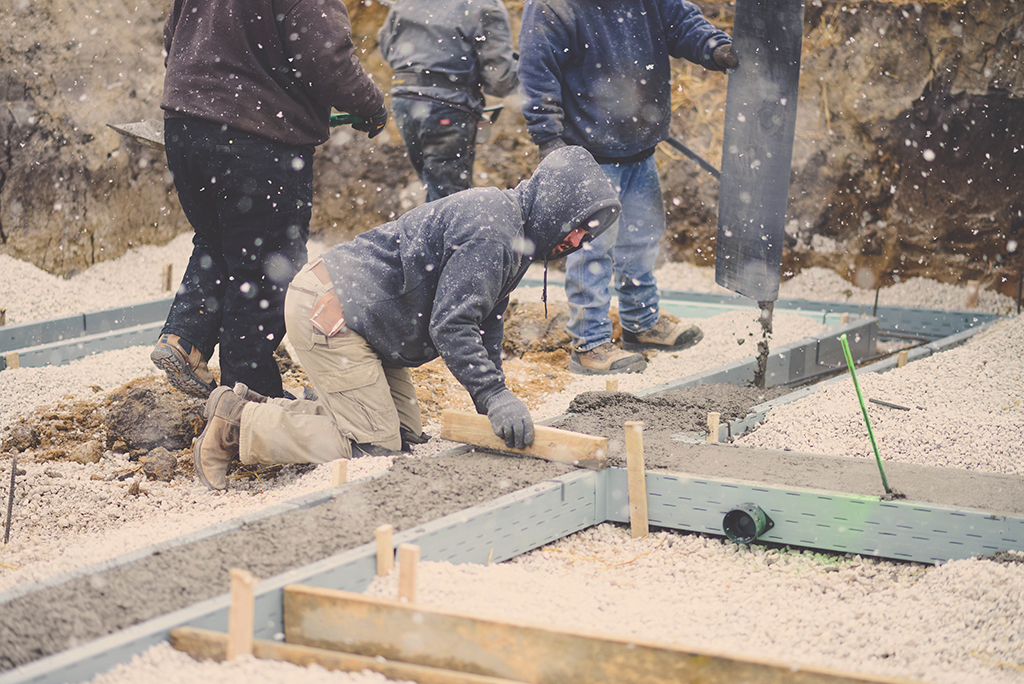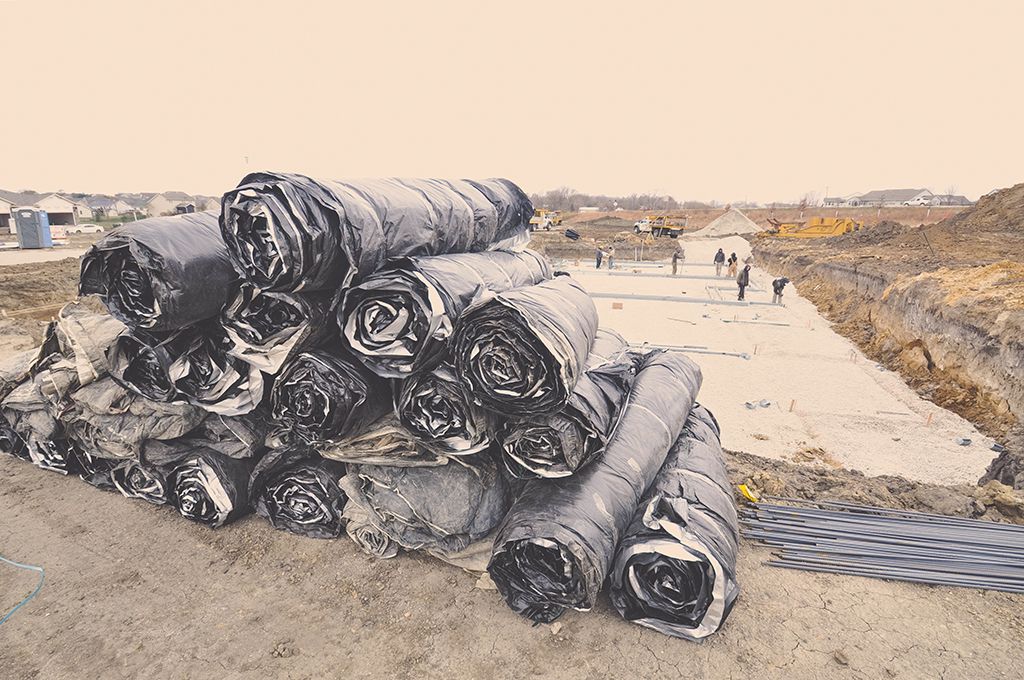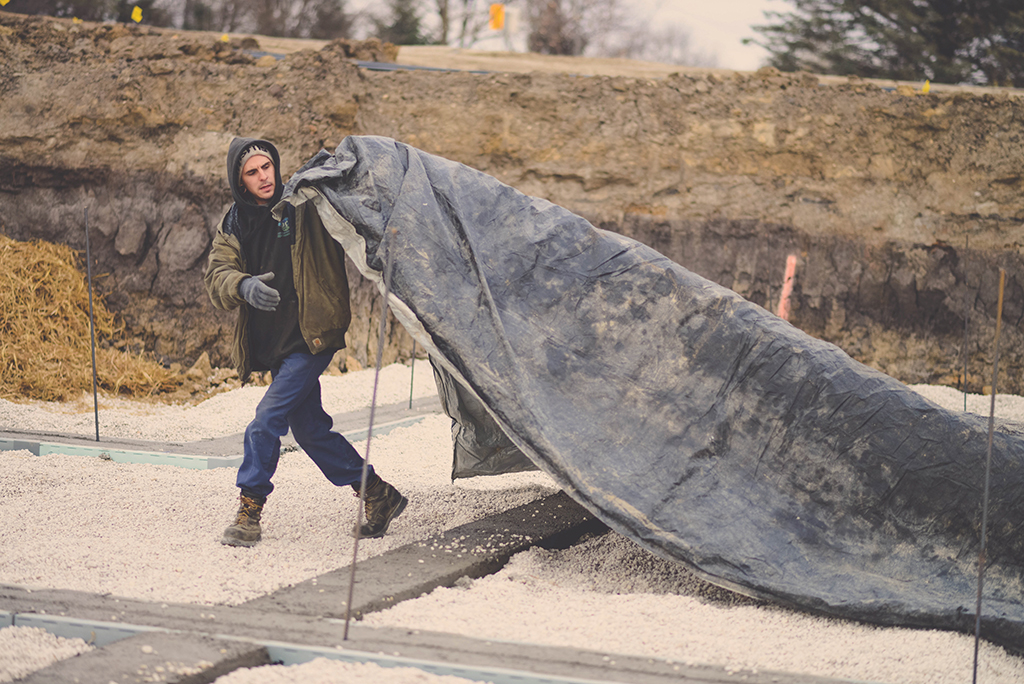Cold Weather’s a-Comin’
Practical Applications of CFA Cold-Weather Research
Every year since 2004, contractors, homeowners, builders, and especially members have contacted the Concrete Foundations Association headquarters looking for information about the performance of and best practices for cast-in-place concrete during the winter season. In advance of the approaching winter, this article offers practical advice supported by the significant research the CFA produced from 2001-04 and some responses to common inquiries. Several additional articles covering more of the basics of cold-weather concrete can be found at www.concretefactsmagazine.com.

It seems obvious that, if properly managed, placing concrete during the winter is feasible, even common. Despite decades of experience and countless markets that undergo moderate to severe cold weather, each year the transition from autumn to winter brings a new sense of concern and finds many in the industry seeking either advice or advocacy. It seems that each market operates with a different concept of what cold actually means. We never stop to think whether the concrete itself knows the weather has turned cold; the reality is that the dropping temperature induces a slowing effect on concrete maturity.
Concrete maturity, the hardening and strengthening from a highly viscous mix into a rock-like structural material, requires a balance of time, temperature, and moisture. Take any course on concrete performance (including the CFA’s preparation course for becoming an ACI/CFA residential foundation technician) and you will come away with a much deeper understanding of the decisions that influence this critical relationship. Adjusting, eliminating, or increasing one factor will certainly impact the result and necessitate adjustment in the other two legs of the “concrete stool” to achieve the targeted result. Therefore, when the air temperature begins to drop, those with rudimentary to moderate knowledge of this tenuous relationship immediately become concerned that poor concrete will result.
Two decades ago, there was a common misconception that hydration, the chemical process initiated when water comes into contact with cementitious material, ceases at 40 degrees Fahrenheit. More recently, there is an assumption that an air-temperature of 32 F is sufficient to “freeze” the concrete. While a large portion of the concrete industry operates outside these fictional beliefs, proving they are false may be a challenge. Today, backed by research, updated technical guide documents, and codified prescriptive standards, there is a recognized platform for professional contractors to prove year-round quality and anticipate the decisions necessary to achieve consistent results. While the research report is available for purchase by anyone interested, association members have enhanced access and the opportunity to leverage the research to produce cold-weather action plans.
The first goal of a cold-weather action plan is to determine the targeted performance. This will depend on the type of concrete project and the concrete placement location. For instance, the maturity time for concrete on an elevated deck in the middle of December will be dramatically different from a slab-on-ground, and more different still from a vertical foundation wall in an excavation. However, with the relevant knowledge regarding decisions to make and protection measures to take, these concrete maturation factors can be manipulated to achieve the targeted performance. Focusing on the concrete foundation industry, the main items that affect the targeted performance are:
- When do the forms need to be removed (or when can they be removed)?
- When will the foundation receive backfill?
- When will the foundation be built on?
- What is the exposure plan for the finished wall?
- What are the projected temperatures during these time periods?
With these primary questions answered, a residential concrete contractor can swiftly make good decisions for cold-weather performance, including decisions about mix design, enclosure, and, when necessary from extreme conditions, provisional heating. The document most often cited for authority on cold weather is ACI 306,1 which states in its introduction:
The objectives of cold weather concreting practices are to prevent damage to concrete due to freezing at early ages, ensure that the concrete develops the required strength for safe removal of forms, maintain curing conditions that foster normal strength development, limit rapid temperature changes, and provide protection consistent with the intended serviceability of the structure.
Since ACI 306 is a guide and not a document of mandatory requirements, there is a lot of variation in what are determined to be the best construction practices. With the ACI 306 objectives in mind, the CFA’s research report2 provides evidence for facts about concrete behavior to help apply these objectives to foundation walls:
- Early-age freeze damage does not occur after a concrete strength of 500 psi.
- Final set is achieved at or below 500 psi.
- Form removal is safe once the final set strength has been reached.
- Strength gain will continue above concrete temperatures of 27 F.
- Strength gain will resume, even if it ceased during a freezing cycle.
These facts about concrete construction, proven through research, should form the basis of any approach taken during cold weather. There are still many decisions to make and options to pursue, but these fundamentals help explain how successful cold-weather concrete performance is much more than possible.
Protection From Freezing
Contractors with less experience often bring up two major concerns when discussing concrete freezing. First is the obvious problem: structural failure. This is most often a warranted concern in elevated or suspended structural applications, but it is never an issue for ground-supported or lightly loaded concrete applications (like a residential foundation).

Though less dramatic, the second concern is more common or probable: surface durability. As the concrete temperature drops below the freezing point of water, ice lenses begin to form in the free water along the surface layers. These ice lenses interrupt the normal hydration process, preventing some of the cementitious particles in the surface paste from developing sufficient strength to remain attached to the rest of the growing concrete volume. Therefore, when temperatures permit thawing or when multiple freeze/thaw cycles occur, the concrete surface is not strong enough to resist the movement and the surface delaminates either as spalling or dusting. Surface deterioration can be both an aesthetic and a durability concern.
ACI 3323 says that concrete compressive strength must achieve 500 psi before being permitted to freeze. At 500 psi, research (like that from the CFA) has proven that the concrete has reached its final set, meaning free water is no longer present and therefore ice lenses cannot form. ACI documents, including 332 and 306, suggest preventing concrete from experiencing a second freeze until it has reached its design strength or 3,500 psi, whichever is lower.
The CFA research shows the various mixes that achieved 500 psi at different intervals under cold to frozen conditions, allowing contractors to select a mix based on the time and severity of temperature exposure, along with whether or not there are other protective measures.
Removal of Forms
For the concrete contractor, productivity is the main motivation for removing forms. Often limited in the amount of form sets, contractors like to strip forms so they can move quickly to the next job. This preference puts pressure on decisions involving timing. During the peak construction season, a basic residential foundation might be seen as a three-day process, once the excavation is completed. Day 1: Form and place footing concrete. Day 2: Set wall forms and place concrete. Day 3: Strip forms and prepare wall for backfill. While aggressive, many contractors have a mindset similar to this when planning how to move form sets across their projects.
The issue of “when” is a much bigger question as air temperatures drop and concern for strength gain is greater. ACI 347R4 states in Table 5.7.2.3 that, in the absence of a specified minimum strength to be obtained before form removal, it is generally assumed that formwork for walls can be stripped after 12 hours.
It is also important to ensure concrete strength is obtained during a cold-weather application so that strength can continue developing and the project can proceed. As previously stated, CFA research identifies 500 psi as the point when final set is reached. ACI’s concrete terminology defines “final setting” as:
a degree of stiffening of a cementitious mixture greater than initial setting, generally stated as an empirical value indicating the time required for the cementitious mixture to stiffen sufficiently to resist, to an established degree, the penetration of a weighted test device.

“Final set” is also widely recognized as the state at which concrete is self-supporting—that is, it will not become deformed by gravity acting on its volume. Once at or past 500 psi, forms are no longer necessary for containing the concrete foundation’s form.
Minimum strength is sometimes specified for form removal prior to beginning work on a concrete element, but this is almost always related to a structural concrete element that will take a large load or will be required to support its own weight along with applied loads across an unsupported span. Again, this does not pertain to the relatively shorter walls of residential foundations and slabs-on-ground. Regardless, a mix design can be selected to easily target the specified strength at virtually any duration. Likewise, an existing mix can be assessed to determine the strength at any given interval.
Achieving Strength Gain in Winter
CFA research offers many different mix designs—44, in fact. Unfortunately, the amount of information can deter the casual contractor from realizing its utility. Beginning with lab-cured cylinders to produce a total of more than 800 specimens, predictive maturity curves were compared to compressive breaks at six common intervals between 24 hours and 28 days. This correlated data has proven concrete’s behavior in sub-freezing air temperatures and attests to the reliability of predicting behavior based on the impact of air temperature on concrete temperature.
Targeting a more specific correlation to foundation wall conditions, a total of six mix designs were chosen from the lab research for the field. Walls were cast and forms were pulled 24 hours later. The wall specimens experienced 20 days of sub-freezing ambient air until the temperatures finally lifted above freezing at the end of the month. Along the way, field-cured cylinders and cores were tested over the same time intervals as the lab in order to further show the confidence in predictive maturity methods. Additionally, blankets for short-term protection were provided on one set of wall samples during the first critical 24-hour period and then removed for the remainder of the test period.
All full-scale wall specimens achieved the minimum protection strength of 500 psi before the concrete temperature dropped below freezing and hydration ceased. All but the leanest mix reached strengths far higher than this. Later, petrography was added to the concrete core specimens to determine the impact of freezing conditions. In line with the concrete reaching the minimum strength, the samples did not have any remarkable signs of weakened durability.
Based on this research and the continued efforts of ACI committees 306 and 332, the CFA frequently analyzes mixes for cold-weather placements for the benefit of member contractors, giving recommendations for alterations to mix specifications for key temperature ranges and short-term protective measures to use with leaner mixes.
A contractor may ask for the performance comparison of a 4,000-psi mix using Type I cement and a mid-range water reducer. This can quickly be compared to the mixes in the research to identify the length of time it takes to reach 500 psi. Knowing this duration, the impact of air temperature on a concrete foundation wall volume temperature can be used to qualify the mix for a temperature range of perhaps 20 F and higher. Should the anticipated temperatures drop to be between 10 and 20 F, alterations of this mix might include switching to a Type III cement, and for a range from 0 to 10 F, the use of an accelerator might be the better protection measure. Blankets capping the top of the wall for the first 24 hours ensures the consistency of protection, and the wall forms may likely be removed the next day.
Emulating or directly correlating any mix produced, delivered, and protected with the practice recommendations found in the CFA’s cold-weather research report has increased quality during an otherwise challenging time of the year. The CFA’s advocacy to communicate these researched recommendations has led to numerous case studies of successful and improved recommended practices for both contractors and concrete suppliers.
A tech note made available to the public from the Toolbox found at www.cfaconcretepros.org offers summary information and communicates several of the most influential best practices. To access the complete research, contact the headquarters of the Concrete Foundations Association.
References
- “ACI 306-16: Guide to Cold Weather Concreting,” American Concrete Institute. 38800 Country Club Drive, Farmington Hills, MI 48331. | Phone: 248-848-3700 | www.concrete.org
- “Casting Residential Foundation Walls in Cold Weather,” Concrete Foundations Association. PO Box 204, Mount Vernon, IA 52314. | Phone: 319-895-6940 | www.cfaconcretepros.org
- “ACI 332-14: Residential Code Requirements for Structural Concrete and Commentary,” American Concrete Institute. 38800 Country Club Drive, Farmington Hills, MI 48331. | Phone: 248-848-3700 | www.concrete.org
- “ACI 347-14: Guide to Formwork for Concrete,” American Concrete Institute. 38800 Country Club Drive, Farmington Hills, MI 48331. | Phone: 248-848-3700 | www.concrete.org







